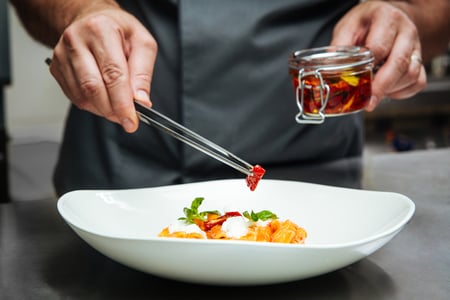At the close of every year, we look forward to food trend predictions for the future. It’s fascinating to see the experts’ forecasts for what consumers will be eating (and avoiding) in the year to come.
One big question many restaurant operators ask: Do food trends matter? We think they do. No one’s saying that operators should dramatically revamp their menus every year to incorporate the latest craze: Mushrooms! Ube! Baked Alaska! But awareness of global dining patterns helps keep offerings fresh and interesting.
Here’s a look at some predicted 2023 food trends.
Interest in “mood food” — and drink — is rising.
“Consumers will look for food and drink that influence cognitive capacity, manage stress levels and optimise brain function,” Mintel says in its 2023 Global Food and Drinks Trend Report.
In general, mood foods are those that combat inflammation and promote overall wellbeing with healthy fats, essential amino acids and B vitamins, explains the Academy of Culinary Nutrition. Examples are chia seeds, lentils, fatty fish such as sardines and salmon, avocado and almonds.
Going one step further, experts are predicting even more of a demand for nootropic ingredients, which promise to boost mental acuity and clarity, and adaptogens, which are herbs and mushrooms that may help the body cope with stress, anxiety and fatigue.
Functional coffee (and coffee substitute) drinks combine all of these trends. One area of interest is drinks with lower caffeine levels, such as Laurina coffee (a naturally occurring varietal) and yaupon, a holly native to the southeastern U.S. Yaupon tea, made from the leaves and twigs of the plant, is seeing a huge upswing in popularity.
Fermented, probiotic and prebiotic foods continue to be a major food trend.
The more we learn about how the health of the gut affects overall wellbeing, the more consumers are interested in eating to support that goal. Nutritionists now advise trying to eat 30 different plant foods every week, which may lead to increased demand for new and varied greens. Industry pros predict continued demand for foods that are high in fiber or beneficial cultures, such as kimchi and koji.
Conscious consumers want to know even more about their food’s sourcing.
Way back in 2018, we wrote about how Gen Z consumers prized transparency in their dining and food-buying habits. That hasn’t changed; if anything, it’s intensified. Labeling something “clean” or “sustainable” is no longer enough. Consumers want to know about the impact of food on climate, and its carbon footprint. They want to know about labor practices and fair wages.
They care even more about animal welfare, too. It goes beyond “cage-free”; the question now is, are chickens able to “act like chickens” by engaging in instinctive behaviors and maintaining emotional wellbeing? That’s the question being explored by the Better Chicken Project, an initiative of the Global Animal Partnership, which is conducting research to help the industry improve the lives of birds raised for consumption. “Slow-growth” and “regenerative” are terms you can expect to see more on poultry-product labels.
Consumers want to eat more vegetables, in nontraditional ways.
New varieties of veggie snacks were a standout food trend at the 2022 Summer Fancy Food Show hosted by the Specialty Food Association. “A new crop of crispy, salt-and-spice dusted products is making the case that potatoes shouldn’t be the ruling king of chips,” noted food reporter Emily Heil. Low-temperature frying in a vacuum renders delicious chips made from peppers, zucchini, onions, asparagus and even tomatoes. Whole mushrooms and even garlic cloves also got the snack treatment.
Veggie-based pasta is another fast-growing category. Consumers are already familiar with cauliflower- and legume-based pasta (which also can be gluten-free). Now, options include pasta made from spaghetti squash, hearts of palm and green bananas.
Consider incorporating more fresh vegetable juices and wheatgrass juice into your beverage menu for health-conscious diners. The FreshMark™ family of commercial juicers maximizes juice yield and is incredibly simple to use and clean.
Simplicity is in.
It may seem counterintuitive, but the same consumers who want more transparency, more health and more functional ingredients also want… less. People are overwhelmed by the amount of information pelting them every day, and so they prefer it when brands tell them only what they most need to know. “Going forward, consumers will look for brands that focus on their advantages on packaging — and save stories for websites, social media and marketing,” Mintel says. It may be time to apply this advice to your menu as well.
Whatever challenges and opportunities 2023 brings to the restaurant business, Hamilton Beach Commercial is here to help you rise to the occasion with durable, labor-saving commercial foodservice equipment. Learn more now.


